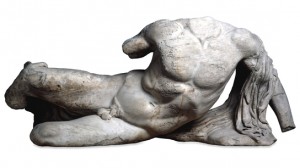The British Museum has announced that it has loaned to Russia one of the sculptures from the Parthenon that widely known as the “Elgin Marbles” after Thomas Bruce, the 7th Earl of Elgin who oversaw their removal from then-Ottoman occupied Greece in 1811-12. The State Hermitage Museum in St. Petersburg is the recipient of the loan, specifically, the sculpture of the river god Ilissos from the west pediment of the Parthenon.

As the British Museum website describes it, the sculpture
figures in the corners of the triangular composition perhaps represent the rivers of Attica. This figure, from the left-hand corner, is thought to personify the river Ilissos, by comparison with figures on the east pediment of the Temple of Zeus at Olympia; the Greek historian Pausanias names them as the local rivers there. The naked youth's languid form is well adapted to the raking angle of the pediment that framed him. He appears as if caught in the action of raising himself onto a rock. A piece of drapery hangs wet and clinging to his left arm.
The controversy around the Parthenon sculptures is complicated, but also simply stated: Greece maintains that the sculptures are Greek cultural heritage that was removed without the permission of the Greek people, and should be returned. The articulation of the British position varies by how delicately the proponent wants to put it, but it ranges between some variation of the more tactful assertion that the marbles were exported with the permission of the then-recognized government (the Ottoman Empire) to the less-empathetic “too bad.”
This dispute, of course, ranges in many forums and there are passionate advocates on both sides. Before today, the most recent newsworthy development was the announcement that Greece had expanded its legal team to include Amal Alamuddin-Clooney, famous in the first instance as a human rights lawyer (and more recently as George Clooney’s wife). Options being considered, it was said, including perhaps pursuing claims in the European Court of Human Rights.
For better or worse, however, the status quo has long prevailed. The British Museum quite clearly has no intention of returning the sculptures, and it is not apparent that there are any legal mechanisms either in the UK or in Europe to compel Britain to change course. Thus, the dispute has been primarily an ethical one.
This loan tips the equilibrium a little off balance. In the first, instance, the travel of the sculpture takes it outside the territory of the UK for the first time in memory. That necessarily lessens the physical control that Britain has long had on the sculptures. Greece does not have any kind of judgment to enforce (so far as I know), but that will not necessarily matter. Recall, most prominently, the Portrait of Wally case. That painting was well known to claimants, who were frustrated by Austria’s refusal to return it. It was the physical transfer to New York for a loan to the Museum of Modern Art that set off a chain reaction, even though the seizure was ultimately unsuccessful, that resulted in a major case and a significant settlement agreement. Few saw that coming at the time.
Cynically, the reason that Britain probably felt safe in this loan is the recipient: Russia. Given Russia’s own cultural property policies and actions, it is almost unimaginable that Greece would find a sympathetic forum in Russia. Lest anyone forget, Russia has been pursuing for more than three years an embargo of cultural artifact loans in retaliation for the judgment against to return the Chabad Library (and the tens of millions of dollars in contempt fines that have accrued for Russia’s defiance of that judgment). Russia is not going to open that Pandora’s box.
So for now, the debate will likely remain on the ethics of the loan: should the British Museum be lending these objects at all? Is cultural exchange an end in itself that justifies this? Should other countries refuse Russia loans while it is doing the same? These are hard questions with no easy answers. But if Parthenon sculpture loans to other places follow, don’t be surprised if one of them ends up putting events beyond the parties’ control and becomes a game-changer.




